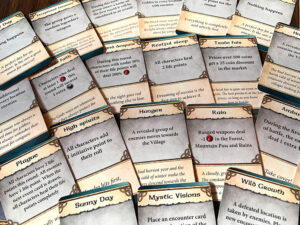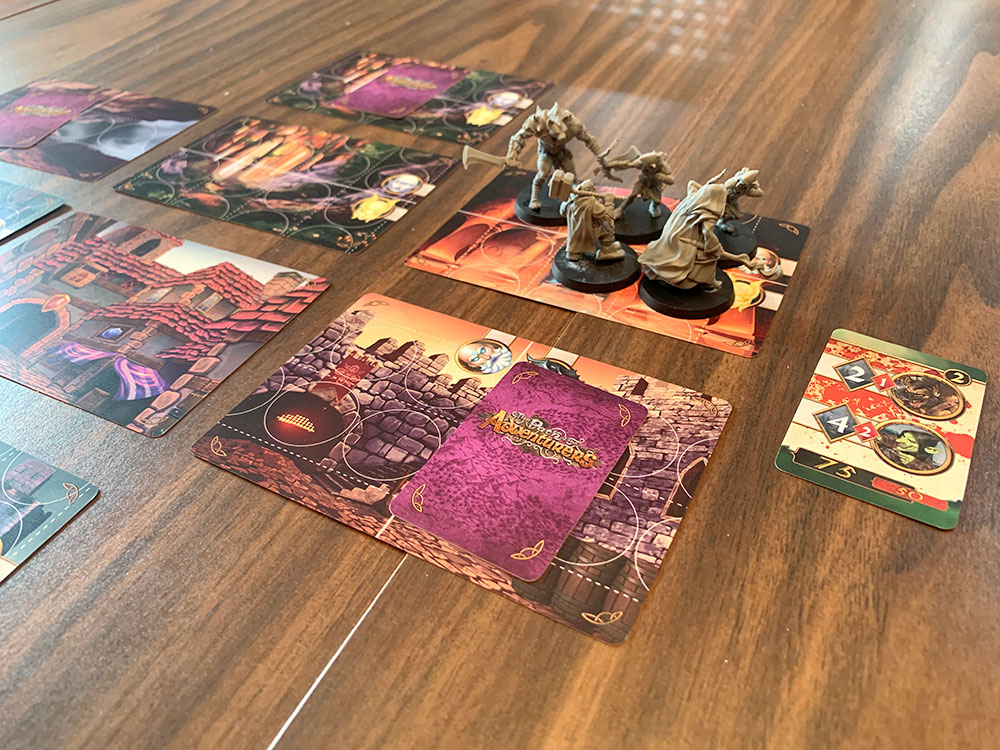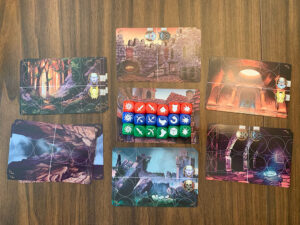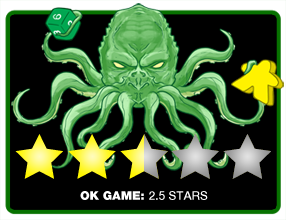 The Path of the Adventurers is a miniatures-based, cooperative adventure game featuring many mainstays of traditional fantasy tropes except that the women are more practically clothed than some of the men in this world. So grab your gear from the tavern’s battered table and let’s set forth on a dice-driven press your luck adventure battling waves of monsters.
The Path of the Adventurers is a miniatures-based, cooperative adventure game featuring many mainstays of traditional fantasy tropes except that the women are more practically clothed than some of the men in this world. So grab your gear from the tavern’s battered table and let’s set forth on a dice-driven press your luck adventure battling waves of monsters.
“Minstrel – play a heroic battle hymn to inspire us all! Charge!”
“And nope. Minstrel – play your best ‘run away’ music!”
There were a few too many gnolls in that mountain passage so let’s cautiously look somewhere else first.
Gameplay Overview:
Once you’ve selected your character, starting item, and skills you get to pick one of the four locations around the city that you wish to explore. You can either assault the area, gaining plus two to your initiative and picking up two fatigue tokens, or you can explore. Either way, flip over the encounter card for that area, set up the enemies, and add your heroes.
First, you calculate initiative and place the highest value hero or enemy on the zero column placing heroes first. Then work your way down the initiative track until everyone has been placed with heroes activating before enemies.

Every character has seven attribute points split between strength, wisdom, and dexterity that are used for attacks/abilities. Spend as many as you’re like and try to roll the symbols required for a success. Landing a success inflicts damage, or some other effect often based on the weapon you’re using. Most skills give you fatigue tokens which reduce the number of attribute dice you’ll get next turn. Spend your attributes to your heart’s content as you’ll gain seven of these each turn minus the number of fatigue tokens you have. But you also need these to defend yourself so you may want to show a little restraint.
Enemies will attack by rolling the number of dice allotted to them for melee or ranged attacks. As enemies fall, others will move up to fill the ranks. They will even flank if given the opportunity.
You can choose to forgo your turn to flee but any vanquished enemies will return the next time you go back to that area. Also, any vanquished hero will return to life (yay!) with one health and lose all their gear (boo!).
When you finally crush your enemies you get to randomly draw an artifact from the two small decks of cards with a matching symbol (shuffled together), earn the gold listed on the enemy card, and gain a skill card matching one of the colors of cards you already have.

Between encounters, if you return to the tavern to celebrate/drown your sorrows you can draw 5 cards from the market deck and shop for improved gear. And who doesn’t love shopping for new gear? The wounded character who needs money to get healed; that party-pooper doesn’t love shopping.
Lastly, at the start of each round (except the first) draw an event card. These cards can reduce healing, advance enemies on the board, or generally make your life challenging—although there are some “no effect” and positive effect cards that will grant you a short reprieve or even give you a boost.
There are several different styles of locations in the location deck and when you visit the second one of an area, you’ll face a lieutenant in addition to the enemy card. When you visit the third one of a style, you’ll face one of the two final bosses (drawn randomly or selected by the players) in addition to the regular enemy card. You win when you defeat the boss. You lose is the entire party dies in battle and you can also lose if a group of explored enemies advances into the town location at the center of the board through an event card.

Game Experience
The first thing you’ll experience if you have the miniatures box is two trays of baggies full of parts on sprues. If you don’t want to clip and trim semi-soft resin parts before gluing them together this may not be the game for you (or just use the included standees). Most of the models were only a few parts with only a handful having seven to 10 parts including the base. Most went together fairly well but a handful had some noticeable gaps but nothing worse than I’ve seen on many games with preassembled miniatures.

The rule book, while containing all the information you need, is not laid out well so you’ll have to jump around to see all the icons and edge case rules. The Path of the Adventurers itself isn’t overly complex for this type of game but there’s a lot of small iconography spread throughout the cards and rules. An example of the graphic design making the game more complex than needed is the symbol for quantities of enemies is the same as symbol for initiative speed. And the choice to put the highest-scoring initiative values on the lowest column value was confusing at first (is this the new math I keep hearing about?). It would’ve been easier and more intuitive to placing initiative tokens by the number of successes rolled and working down from highest to lowest.
The Path of the Adventurers aims to give you a quick to set up and fairly streamlined dungeon-crawl/minis-on-a-map game without a campaign or paragraphs of narrative. And it does succeed in that aspect as you explore areas, defeat enemies, and become more powerful through the acquisition of equipment and skills. Fortunate draws of the artifacts found can make the game much easier but even unlucky draws are generally useful early on. And with no character restrictions feel free to give your pious battle cleric the dark sword of mega damage; I’m sure his soul will be fine.

Typically, I don’t mind some randomness in combat as I think it captures the frantic nature of battle. There’s minimal luck mitigation available here so that attempt with your best skill may have you opting to roll a huge handful of dice and then whiff it hard. The large amount of fatigue you’ll take with some skills will affect your next turn and possibly your chance of defending attacks against you this turn. Your enjoyment of push your luck elements in games may be a deciding factor in your overall enjoyment of The Path of the Adventurers.
Another place where the randomness can be brutal is the encounter cards. If you draw all level three and four encounters that surround the town to start, your game will be much shorter than the 60 to 90 minutes listed on the box. While you can retreat that your party of intrepid adventurers will likely have taken some damage before you can Monty Python your way back to town. Additionally, the draw of an event card could lead monsters to town, also ending the game.
And herein is a fundamental problem with the start of the game. You can be hopelessly outmatched or forced to retreat which could also end the game with an unlucky event card. Because even if you find another set of enemies to vanquish those same level 4 enemies are still there waiting to advance. I was tempted to play with a self-made variant to only have level 1 cards adjacent to the town to alleviate the issue.

While the game plays 1-4 players, it was balanced for two or four characters. Three characters will either be too hard or too easy depending on which set of enemy numbers you use (the rules recommend using the full values for a three-player game). Two players will power up more quickly, as gear is only split two ways, although there is a chance that the artifacts you find won’t be valuable after you’ve gotten a few. Healing costs 100 gold per character so two character games may need to battle multiple times before they can afford healing, if they survive that long. There are variants in the rules that allow for half to full healing after each battle which feels almost required. When not healing between battles I skipped the market to buy gear as nearly all of my group’s gold was going for the healer.
Meanwhile the characters themselves all have a special ability and slightly different array of attribute dice. This gives a subtly different feeling but it’s the skills you acquire over the game that makes each character unique. And a choice of skills can lead characters to spend their turns buffing or healing other characters which can feel a bit underwhelming. It may be critical to your success to give extra attribute dice to the person with the awesome weapon but it’s not as fun as battling the bad guys yourself.

The two biggest shortcomings of the game are the rules, as they’re unclear at times, and game balance. For example, there’s an event card that tells you to place an encounter card on each unexplored location but when locations are added an encounter card is placed there face down so you know it hasn’t been explored. Another example is with how skills are gained in whatever colors you hold but the default setup has you picking two of four random cards of a singular color. Meanwhile the skill cards themselves are described in the rule book as being of four different colors but there were six different ones in the box with some of the colors being frustratingly close to each other.
Balance can be equally wonky. In one game I drew an event card which gave each enemy one health and heroes two health. I went to the final battle and won with some basic attacks beating the big bad in a single attack for an underwhelming, and cheesy, victory. Another time I had an axe that did splash damage. Splash damage is defined as doing X (four in this case) for each special symbol rolled to adjacent enemies. I rolled all my dice and luckily landed four of those symbols, plus the symbols to land the attack, damaging my target for four damage and the Lieutenant next to them for 16(!). As epic as it was, it just felt overpowered and unbalanced.
Final Thoughts
Some of my favorite things about campaign games are gaining new abilities and better equipment to take on more challenging foes. The Path of the Adventurers offers that type of experience in a single game session. The lack of luck mitigation takes away from that progression as some abilities just aren’t worth the fatigue compared to just using the awesome weapon you just found because the extra damage at the expense of fatigue doesn’t always pay off.
Overall, assuming your game doesn’t end too quickly or you implement your own house rules, The Path of the Adventurers is a decently fun one-shot adventure in a generic fantasy world. The randomness adds some replay value but it also makes the gameplay itself just okay. Several games that I’m considering as comparable use a Yahtzee style mechanic where you roll dice, assign one or more of them, and then roll any not assigned. That provides some level of luck mitigation and makes you feel like you’re in control of your own fate. And as I compare this to those types of dice driven games I don’t see The Path of Adventurers displacing those titles in my collection.
Final Score: 2.5 Stars – The Path of the Adventurers combines campaign-style progression with press your luck dice mechanics in a one shot adventure game.
 Hits:
Hits:
• Characters progress and grow over the game
• Characters can have epic turns
• Relatively quick setup (if you ignore miniature assembly)
Misses:
• Rule book and graphic design is subpar
• Randomness can end the game in minutes
• Minimal luck mitigation






















